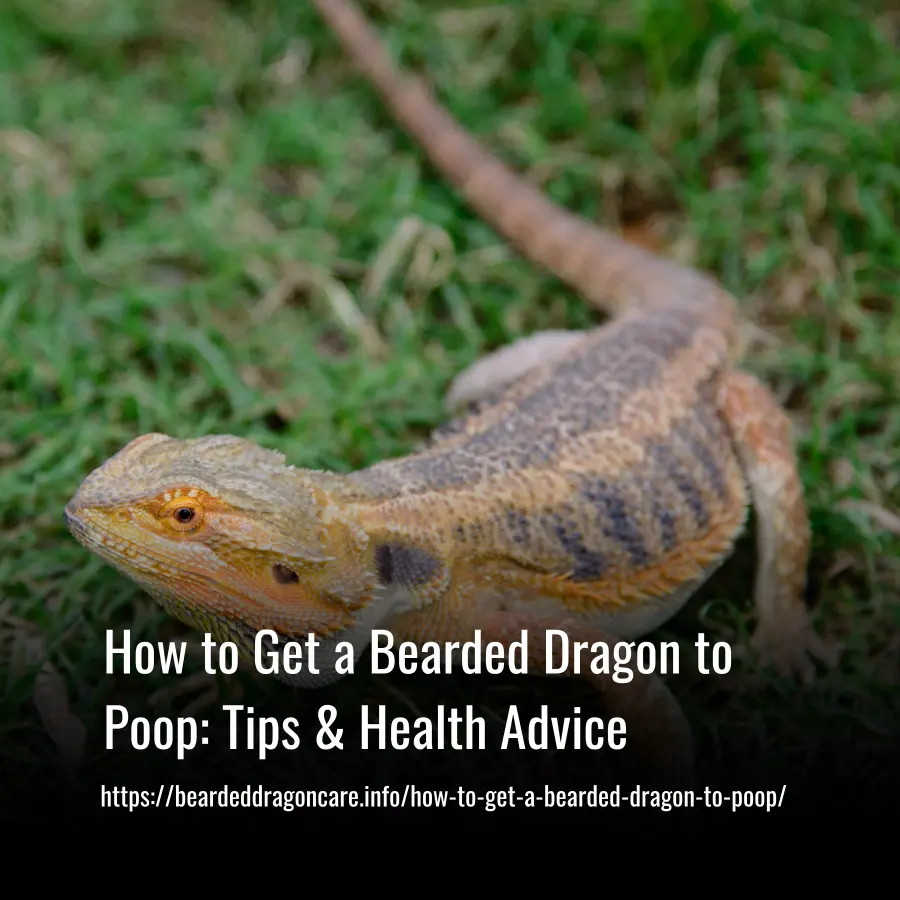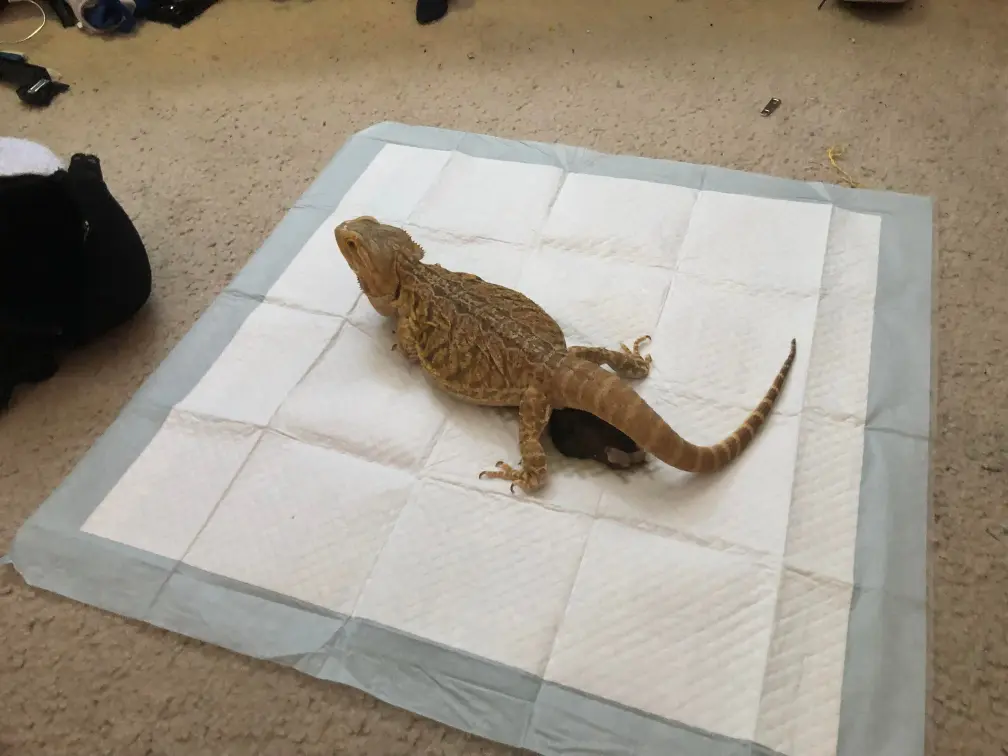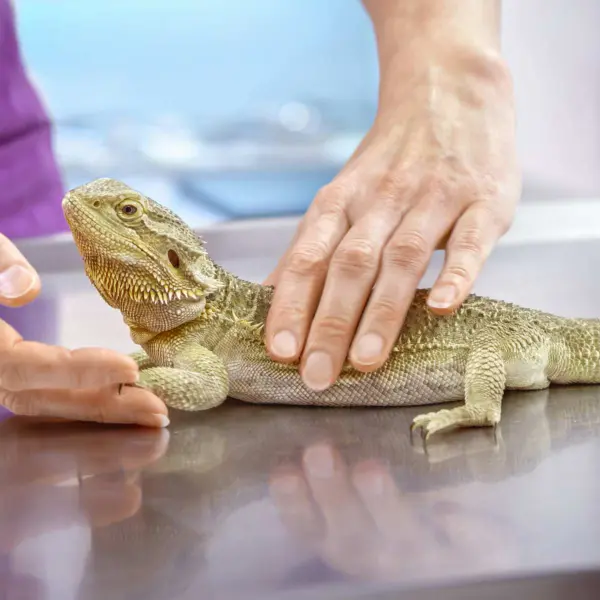How to Get a Bearded Dragon to Poop: Tips & Health Advice
This post contains affiliate links. As an Amazon Associate, we earn from qualifying purchases.
Bearded dragons are lovable and cuddly creatures, but if your bearded dragon isn’t pooping as it should, it could be a sign of a more serious health issue. Knowing how to get your bearded dragon to poop can help identify these issues before they become worse.
The most important thing to understand is that successful pooping starts with providing the right diet. You will need to provide food that is nutritious and high in fiber so your dragon’s digestive system can work properly.
In this article, we’ll look at the best ways for getting your bearded dragon to poop and discuss any potential warning signs you should be aware of if things start going wrong.

How to Make Your Bearded Dragon Poop
When it comes to ensuring the good health of your bearded dragon, regular pooping sessions are essential. If your pet hasn’t had a bowel movement in accordance with their natural schedule, there might be several reasons behind that such as dehydration, stress, or it is too cold.
All of these require attention and should be dealt with to either prevent impaction or other complications. So, when you are wondering how to make your bearded dragon poop, there are certain steps that can help get things going again.
Hydrate Them
To help your bearded dragon poop, it’s important to make sure that they are properly hydrated. Dehydration can often lead to a bearded dragon struggling with its elimination, causing them to produce less than ideal waste.
To determine if your bearded dragon is suffering from dehydration, check the consistency of their urate; a dehydrated beardie will have chalky, dried out poop instead of something more soft and pliable.
Thankfully, you can easily provide them with extra hydration by drip feeding them a couple of drops of liquid on their snout for them to lick up. This simple trick should do wonders in helping your lizard stay properly hydrated and alleviate any difficulty they might be having with regard to pooping or eliminating waste.
Give Them a Bath
Giving your bearded dragon a bath is one of the best ways to make sure they poop. The warmth of the water helps relax them, making it easier for your beardie to eliminate. Plus, if you’re dealing with an impaction issue, this can help with that as well.
To make sure your beardie gets the most out of the bath, it’s important to ensure they remain calm and stress-free throughout its soak. Too much stress can make matters worse rather than better so keep an eye out for signs like whimpering or running away when you set up their bath. If you notice any of these signs, take a break from bathing and try again when they seem calmer!
Double Check Tank Temperatures and UVB
When it comes to making sure your bearded dragon poops, you want to make sure you double check the tank temperatures and their UVB exposure. If either one is off then your bearded dragon will be having issues with digestion and pooping can become a serious issue.
You need to make sure that the basking temps are in range for whatever age your bearded dragon is; 95-105 degrees Fahrenheit for those 12 months of age and older, while baby dragons should have more heat with 105-110 degrees Fahrenheit. Having the right amount of UVB will also help ensure digestion and poop output are normal.
Give Them a Special Homemade Laxative
If your bearded dragon is having trouble pooping, you should consider giving them a special homemade laxative. The best way to do this is by offering them 3-4 drops of pure olive oil per day. This natural laxative will help to gently stimulate their digestive system and encourage bowel movements—without causing any kind of harm to your beloved pet.
It’s important to use only olive oil and not vegetable oil for this purpose. With regular use, you’ll soon be able to tell the difference in your bearded dragon’s bowel health!
Remove Loose Substrates
If your bearded dragon has been having difficulty pooping, a likely culprit is a substrate that you’re using. Loose substrates such as sand, alfalfa pellets, and soil can easily become ingested by your pet and cause blockages or impaction.
To avoid this from happening, it’s important to remove any loose substrates from the enclosure so that it does not pose any potential risks for your dragon. Doing this will help to increase the chances of your bearded dragon passing its stool without difficulty.
Use a Syringe to Feed a Mix of Pumpkin Puree and Water
If you want to help your Bearded Dragon poop, then one of the best strategies is to use a syringe. This method requires preparing a mix containing pumpkin puree and water which you can feed into the Bearded Dragon through the syringe.
The pumpkin puree helps to break down the food and make it easier for digestion. Additionally, the water content of this mixture lubricates its path through the digestive system and ensures proper evacuation when the time comes.

What Can You Feed Your Bearded Dragon to Make Him Poop
In order to make sure your bearded dragon is pooping regularly, you need to provide them with the right foods in its diet. This includes a variety of vegetables, fruits, and insects such as crickets or mealworms.
Additionally, it’s important to give your bearded dragon some moisture-rich foods like cooked squash, canned or cooked beans, and cooked sweet potatoes. These ingredients act as natural laxatives helping with bowel movements.
Also, don’t forget about the essential vitamins and minerals that are necessary for proper digestion. Make sure that your bearded dragon is getting enough calcium and vitamin D3 in their diet.
Finally, providing a shallow water dish is highly recommended as this will not only help keep them hydrated but will also help promote regular bowel movements. So remember to factor in all these elements when feeding your beloved furry friend!
Reason For Not Pooping and Treatment
Wrong Diet
The wrong diet is one of the main reasons why your pet might not be pooping. To ensure that they are getting the nutrition they need and to prevent constipation, it’s important to make sure that the ratio of insects to plants you are feeding is right for their age. You should also rotate vegetables and fruits daily so that they have access to new salads all the time.
Additionally, dusting all insects and salads with vitamin and calcium supplement powder can help improve digestion and make sure your pet is getting enough nutrients. This will lead to healthy poops in no time!
Dehydration
Dehydration is one of the biggest reasons why a lizard may stop pooping. To tackle this issue, it’s important to ensure your lizard has access to plenty of water both internally and externally.
For starters, give your lizard two warm baths every day for 15 minutes each. The water should be warm, but not hot and shallower than your dragon’s shoulders. It is also advised to offer electrolyte drinks such as Pedialyte in an eyedropper onto your dragon’s snout. This provides valuable hydration and helps reduce stress.
Furthermore, try feeding your dragon with a mix of pumpkin puree and water using a syringe twice daily. To further help with rehydration increase the tank’s humidity level to 40%. Keep up these treatments until your dragon starts pooping again!
Wrong Tank Temperature
Wrong tank temperature is one of the most common reasons your lizard may not be pooping. To ensure the optimal temperature for your pet, use an infrared thermometer to check their tank multiple times throughout the day, particularly in the early morning.
The ideal temperature range should be between 98 and 100°F at their basking spot, with an average range of 80 to 85°F on the cool side.
If your lizard has been feeling too cold, you can apply a heating pad for immediate relief. On the other hand, if they’re getting too hot, provide them with a large shallow dish filled with cool water for them to soak in. With proper temperature levels and daily hydration, you can help get your lizard back on track and ready for waste removal!
Underfeeding
Underfeeding is one of the main reasons why your bearded dragon isn’t pooping and it needs to be addressed. Studies have found that adults who were being fed fewer than 35 large crickets and a ½ cup of salad each week, or hatchlings with reduced feeding frequency, were not getting enough food.
This means that if you think your bearded dragon may be underfed, you should increase their food intake – especially for hatchlings – so they’re receiving adequate nutrition. For adults, you should make sure they’re eating at least 35 large crickets and a ½ cup of salad per week. It’s also important to give them plenty of variety in their diet.
Impaction
Impaction is one of the potential causes for a bearded dragon not to poop. If your pet lizard hasn’t pooped in more than 24 hours, then it’s possible that they are suffering from impaction. Oftentimes, this is due to wrong substrates and temperatures.
The best way to treat impaction is with warm-water baths and massages. Start by soaking your bearded dragon in a warm bath for 15 minutes twice each day, followed by gently massaging its stomach. You should also give them vegetables with drops of olive oil (0.1 mL per 100g of the lizard’s weight).
If no pooping occurs after 24 hours, simply repeat steps 1-3 until you begin seeing some results. However, if another day passes with no pooping it’s recommended that you take them to the vet immediately for further examination and treatment.
Wrong Lighting
Wrong lighting can be one of the reasons for not pooping and it’s a common issue. If you are experiencing this, it’s important to have the proper lighting setup for your reptile. Specifically, using the wrong intensity or type of UVB bulb can cause your pet to suffer from health complications.
For best results, it’s recommended to use a 10.0 or 12.0 UVB bulb with between 70 and 100 watts placed above a basking rock. It’s also important to switch out the UVB bulb every six months and not use a coil as that could end up being harmful to your reptile.
How to Massage a Bearded Dragon to Poop
Massaging your Bearded Dragon is a great way to stimulate them to poop. There are 2 Ways To Massage A Bearded Dragon To Poop.
Gentler Side Massage Without Water
It is possible to massage a bearded dragon in order to help them poop without involving water. This can be done by first gently massaging the beardie’s side from head to tail for 10 minutes, with 1-2 minute intervals. Make sure not to press too hard as impaction already presses on the reptile’s spine and other internal organs.
Once this is done, let your pet rest and add a drop of olive oil to its nose. This encourages your pet to instinctively lick it off while cleaning its nose. Then offer some small bites of pureed pumpkin, prune, apple, or watermelon – whichever your reptile seems interested in – as Beardies often avoid eating fruits during impaction.
Olive oil can be beneficial for treating impaction, however, make sure you only use organic olive oil and not mineral or vegetable oil. If the problem persists even after three days, it is advisable to consult a veterinarian as soon as possible.
Abdomen Massage With Water & Pressure Exerted
Massaging a bearded dragon’s abdomen with water and pressure exerted is an effective way to help it poop. To do this, you’ll need lukewarm water, a dry towel, canned pumpkin diluted with water, and a bit of olive oil.
Start by taking the beardie out of its enclosure and submerging it in shallow lukewarm water for 30-60 minutes while gently massaging your pet. This will help rehydrate and release any impaction that might be causing constipation.
Continue massaging by applying pressure with your fingers on both sides of the abdomen. Put both thumbs on the back of their body and rest beneath their belly so that you can massage their abdomen in a circular motion, putting gentle but not too much pressure on them. Also, use your hand as support to keep them upright while you massage from the throat down to their tail.
When done properly, using this technique can help make your bearded dragon defecate more easily – particularly if they have been impacted for over two weeks – while also nourishing its health and preventing impactions in the future.

Conclusion
In conclusion, getting your bearded dragon to poop is not extremely difficult. It just requires a little bit of patience and understanding. Make sure you are providing your pet with plenty of water and food, as well as a comfortable environment for them to live in.
Stick to a regular schedule for feeding, exercising, and basking, and be sure to check on them regularly to make sure there are no signs of health problems.
